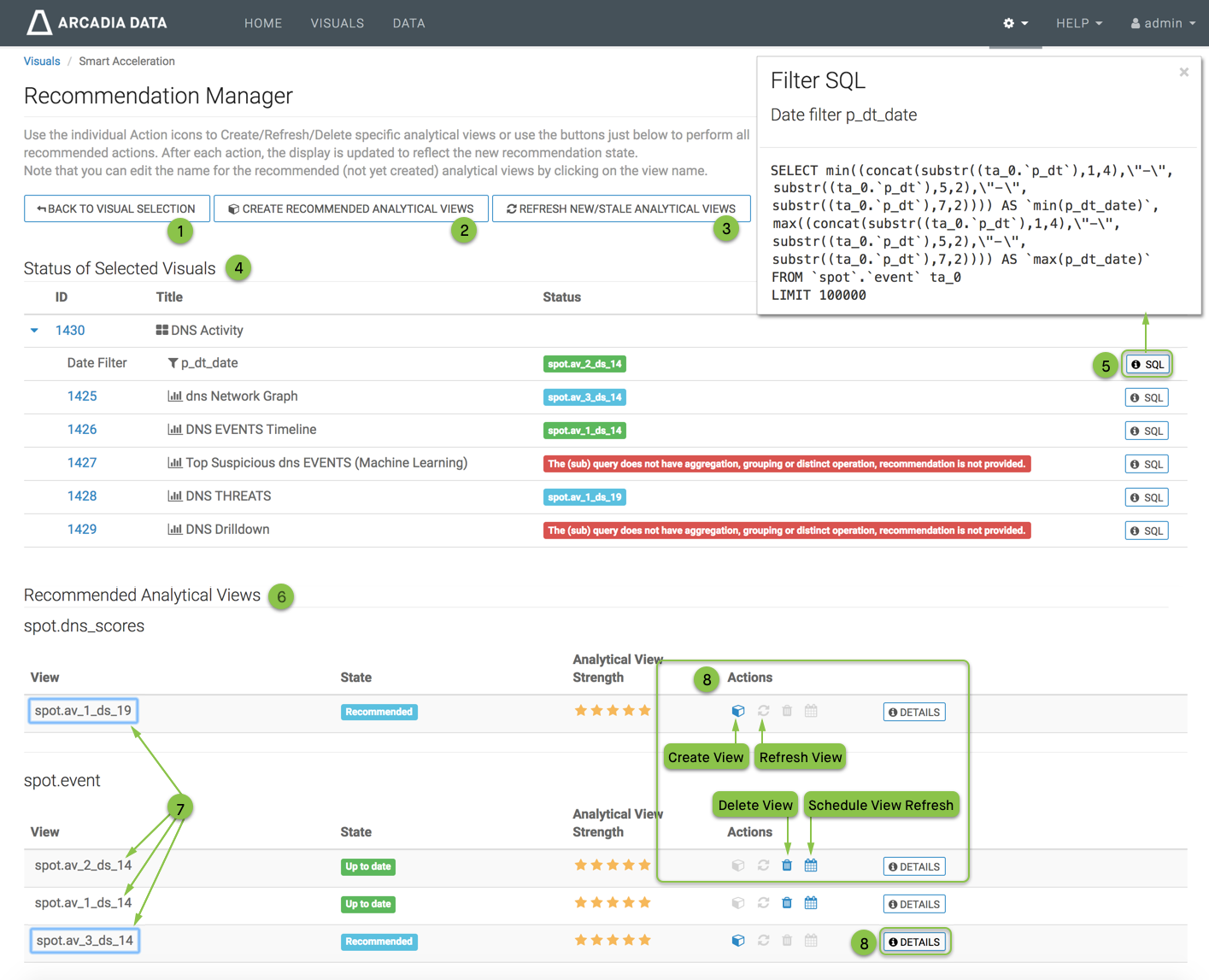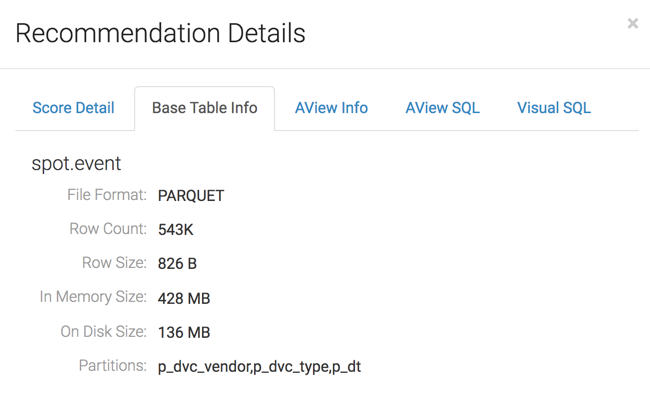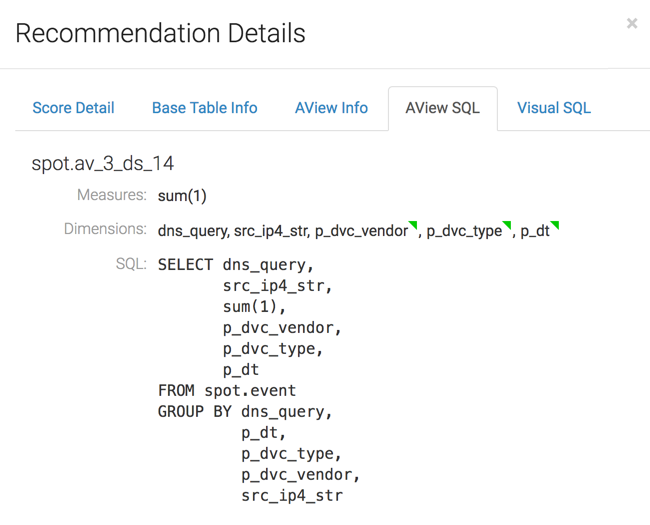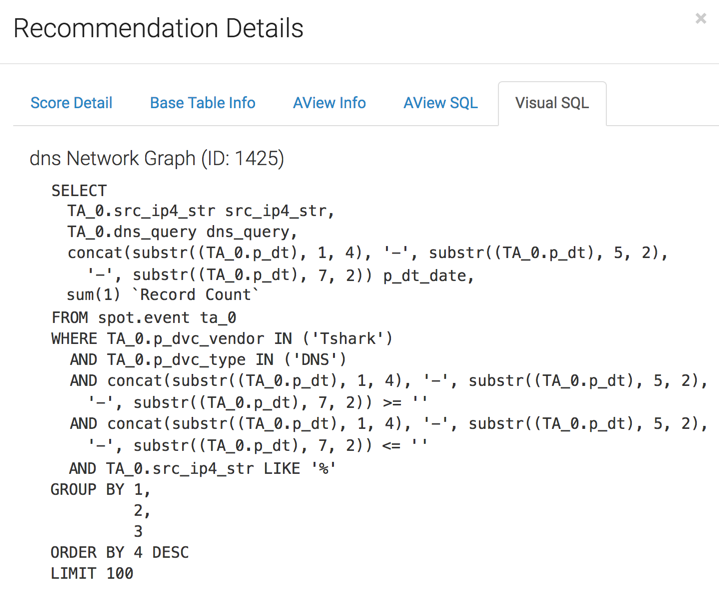Understanding the Recommendations
When the Recommendation Engine reports its findings, notice the features of the interface and the actions you can now perform:

- To choose another app, click Back To App Selection.
- To start implementing the advice of the Recommendation Manager, click Create Recommended Analytical Views.
- To ensure that the analytical views are ready to use, click Refresh New/Stale Analytical Views.
- Status of Selected Visuals table shows the ID and Title of each visual and filter in the dashboard, the Status of the recommendation (green for 'existing', blue for 'recommended', red for 'not provided'), and the clickable link for SQL.
- To see the SQL definition of each artifact on the dashboard, click the corresponding SQL option in the Status of Selected Visuals list. Here, we are showing the SQL definition of the date filter p_dt_date.
Recommended Analytical Views table shows both existing and recommended analytical views, and has the following information columns:
- State (Up to date, Stale, Needs initial refresh, Invalid, or Recommended)
- Analytical View Strength, a scale of 0 to 5 stars, from week to strong
- Actions available for analytical views
- Details
Note that when dashboards use multiple base tables, the recommendations group accordingly.
- You may rename the recommended analytical views by double-clicking on the name. This is not possible for existing analytical views.
-
The available Actions for each analytical view appear on each status line. They are:
- Create view
- Refresh view
- Delete view
- Schedule view refresh
You can see analytical view definitions in the Recommended table by clicking Details. It has several tabs with information about the recommended view, the base storage structures, and the requesting query (either the visual or the filter):
- Score Detail
- Aview Advantages
- These considerations determine the rating of the analytical view.
- File format conversion
- Analytical views are always in parquet format. If original data is not in parquet format, then converting to an analytical view applies parquet's default compression techniques.
- Join materialization
- Join computations are cached, eliminating the need to perform join computations after query routing.
- Data reduction
- Aggregation functions can result in data reduction. Analytical views cache the results after aggregation, eliminating to perform these computations after query routing.
- Incrementally refreshable
- If analytical views are partitioned, they can be incrementally refreshed. Only the partitions containing stale data will be refreshed, leaving the valid partitions untouched.
- Score breakdown
- The following elements indicate how the score is calculated.
- Max possible score
- This number is 5.
- Deductions / No Deductions
- This number is subtracted from the maximum score.
- Total Score
- This number represents the final rating after applying deductions.

- Base Table Info
- Table Name
- The name of the table appears in the form
database_name.table_name - File Format
- Format of the table, such as
PARQUET - Row Count
- Number of rows in the table
- Row Size
- Typical size of each row, in Bytes
- In Memory Size
- The size of the table when stored in memory, in Bytes
- On Disk Size
- The size of the table when stored on disk, in Bytes
- Partitions
- The names of the columns that partition the table; can be none or several

- AView Info
- Aview Name
- The name of the analytical view appears in the form
database_name.aview_name - File Format
- Format of the analytical view, such as
PARQUET - Row Count
- Number of rows in the analytical view; on recommended analytical views, this number is an estimation
- Row Size
- Typical size of each row, in Bytes
- In Memory Size
- The size of the analytical view when stored in memory, in Bytes; on recommended analytical views, this number is an estimation
- On Disk Size
- The size of the analytical view when stored on disk, in Bytes; on recommended analytical views, this number is not available, so we report is as To Be Determined (TBD)
- Partitions
- The names of the columns that partition the analytical view; can be none or several

- AView SQL
- Aview Name
- The name of the analytical view appears in the form
database_name.aview_name - Measures
- Measures used in analytical view; these are typically aggregations, such as
sum(1) - Dimension
- Dimensions used in analytical view; dimensions that match a partitioning column have a green triangle flag
- SQL
- The SQL
SELECTstatement that defines the analytical view

- Visual SQL
- Name of the Visual and its ID
- The name of the visual that originates the query request, and its ID, in the form visual_name (ID: visual_id)
- SQL
- The SQL
SELECTstatement that defines the visual

- Score Detail
Proceed with Create Analytical View.